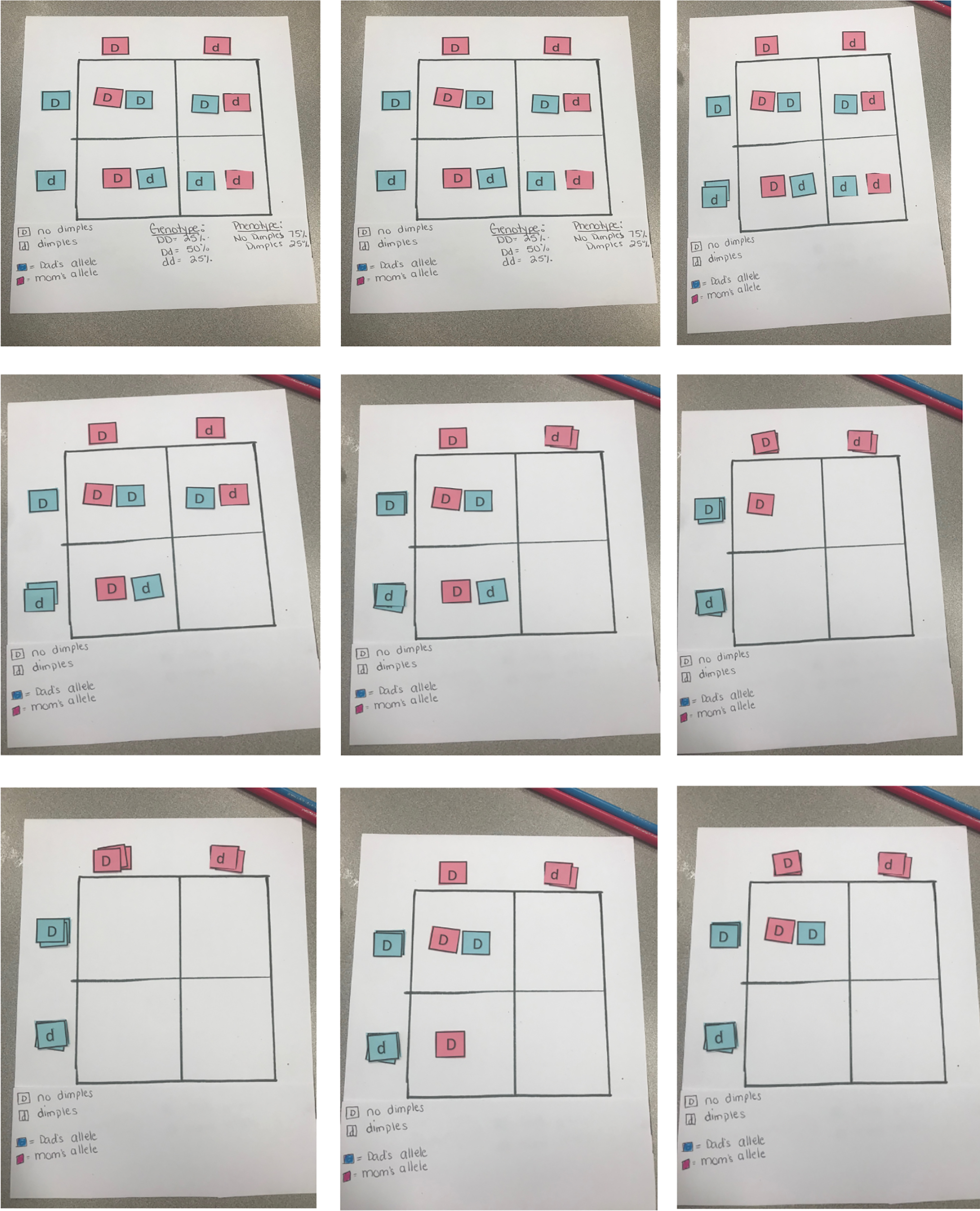feature
Using Pop Culture to Teach Genetics
Teaching patterns of inheritance using students’ favorite celebrity couples
Teacher: “Class”
Students: (All students look forward and track teacher as she speaks.)
Teacher: “Class, as I was saying, today we are going to learn about genetics.”
Students: (All students nod in unison).
Teacher: “Genetics is important, which is why we’re going to learn about it.”
Students: (All students nod in unison again, listen quietly, take notes and begin to learn.)
Perhaps this is a scene from a movie, where zombies have abducted the bodies of my real high school students. As a teacher, I know that it takes a lot more than just telling my students that a topic is important for them to find value in the lesson. I am passionate about what I teach, and I have learned that in order to get my students as enthused as I am about a subject, I need to utilize topics that my students are already interested in, then create a link between that and the science objective.
The framework for this type of instruction is often referred to as Culturally Relevant Teaching (Gay 2010; Ladson-Billings 2003). CRT engages learners in the classroom by taking into consideration the things that they value and establishing relationships between their interests and the science content. A well-designed CRT lesson allows students to progress not just academically, but also to develop their social awareness about how science is important in the world around them (Laughter 2016).
Infusing pop culture into any lesson can be fun, but I need to ensure first and foremost, that the lesson meets the science learning objective. With that in mind, I am free to be creative and make my lessons more engaging. In order to make a lesson relevant to students, it is important to stay up to date on events and individuals that your students follow. You don’t have to start hanging out in the malls and reading Teen Vogue on a regular basis, but you will need to form good relationships with your students early on. Forming meaningful connections at an early stage will create a classroom culture that shows you value each student.
I like to start out the year with a student questionnaire so that I can learn more about my students’ interests outside of school. Throughout the year, I refer to their responses in order to incorporate these interests into my lessons. In doing so, I can avoid introducing topics that I think are “cool,” and instead focus on who and what my students are actually interested in. I also make a point to select families who are known for having a positive impact in their industry and community, so I do not inadvertently endorse any negative behaviors or stereotypes.
Engage
Once you have identified the pop culture icons that your students are following on their social media platforms, select a family to use for your Engage activity (preferably one with a well-known mom, dad, and children). Once you have chosen the family you want to use, search online or in a magazine for a picture of the family members. Next, display the image using a projector or smartboard.
To start off the lesson, ask your students if they are familiar with the family being displayed, then watch as your students eagerly explain to you who they are and what exactly makes them so famous. Once the students have shared a few fun facts about the family, extend your questioning to ask them, “Other than nice cars and a high-fashion wardrobe, what else do the family members have in common?” It is important to guide their responses to some of the inheritable traits of physical features that the parents and offspring share.
Explore
For the next part of the lesson, students will be given two different pop culture families and asked to group each member into the correct family. Prior to the lesson, select another famous pop culture family. Cut the family members out into individual pictures and place them into a plastic bag. Do the same for the second family, placing those pictures into a bag too. Provide one sealable bag per group that contains cut-outs of both families.
Next, have the students work in small groups of three or four to match each individual to the correct family. When students have completed this task, allow them to explain how they determined who belonged to each family. Guide students to share what physical traits the family members have in common and extend their thinking further by asking them, “Why do the members of the family share these physical traits?”
Explain
At this stage of the lesson, your students will most likely have identified DNA as something that parents and their children share. Students might also begin to discuss how they themselves have inherited features from their own parents through DNA as well. It is not uncommon to hear a student say, “I got all of my traits from my mom and nothing from my dad,” or vice versa. Students often have a misconception that only one trait is inherited or passed down from either the mother or the father. Although traits are expressed differently, everyone always receives half of their genes from one parent and half from the other. To illustrate this fact, students will make a color-coded Punnett Square.
For this activity, have students work individually or in pairs. Give each student a bag labeled dad. Inside this bag, place pre-made square paper cut-outs, about an inch on each side. On half of the cutouts, print a capital letter B, and on the other half print a lowercase b. Each bag should have 8–10 copies of each letter. Repeat the same steps for a second bag but instead, label this bag mom. To distinguish between the two bags, choose two different colors for each parent; for example, use blue paper for the dad and pink paper for the mom.
Next, have students place all of the blue capital letters (representing dad) at the top of the Punnett Square in a neat stack. Following this, ask them to place all of the blue lowercase letters (representing dad) next to the first stack (see Figure 1). Students will repeat the same steps with the pink pieces that represent mom.

Punnett Squares.
Now, have students place one piece from mom and one piece from dad into each box, thus illustrating how offspring inherit one copy of each trait from each parent. At the end of the activity, students should have distributed half of the traits from each parent into every box of the Punnett Square. This will provide a great visual aid that students can refer to in order to understand that offspring inherit half of their traits from each parent.
Help the students to understand that each letter represents an allele, and allele combinations provide the outcomes of our traits. The combination of traits in each box is what makes up the genotype, and the physical representation of these traits are called phenotypes. Phenotypes are the traits we can see when we look at our friends or classmates (eye color, skin tone, etc.).
To relate the activity back to the initial family used during the Engage part of the lesson, use the names of the pop-culture family instead of labeling bags with mom and dad. This provides a more specific example for students to use as they learn about Punnett Squares.
Elaborate
To extend your students’ understanding of how to use Punnett Squares, place students in pairs. Give each student a male and a female pop culture icon in a closed envelope. Tell the students that they are entertainment reporters who have received the inside scoop on the newest celebrity couple. Not only have they received this information before any other media outlet, but they have also learned (from a source close to the celebrities) that the new couple is expecting a baby. Explain to the students that they can now open the confidential files they have received, and they should use this information to complete the E-News Report Activity that will be placed in the entertainment section of the local newspaper.
To make the activity more interesting, choose people from various genres of pop culture and watch as your students are amused at the uncanny couples that are paired together for this activity.

Students will use the information in their confidential envelopes, which includes the genotype and phenotype of both parents, to complete the top section of the E-News Report. Once students have the parents’ information, they can complete the remainder of the activity and practice completing Punnett Squares, determining the allele frequency for each trait in their offspring.
Evaluate
To assess the students’ understanding of using Punnett Squares, have them practice independently. Ask them to complete Sponge Bob Genetics (see Online Connections), which uses characters from a popular cartoon to allow students to practice creating Punnett Squares and apply the genetics vocabulary terms that they have learned during the lesson. This fun activity provides various genetic examples so that students can demonstrate their understanding of how to use a Punnett Square. Celebrity families are great examples for pop culture but this activity, using a very popular animated television show to provide students with several genetic problems, offers them an opportunity to apply what they have learned.
Conclusion
However you choose to incorporate popular culture into your lesson, it is important to realize that students do not readily make connections between what they read about in science class and the world outside of the classroom. Consequently, it is important to assist students in making these connections. Biology is, by definition, the study of life, and therefore includes the study of your students’ lives as well. Utilizing your students’ culture and interests invites them to learn and engage, creating a more meaningful and relatable learning experience.
Glossary
Allele: each gene has two forms that produce a characteristic in an individual, such as eye color.
- Recessive Allele is a form of a trait that is only expressed when an organism has two copies and is unexpressed when a dominant allele is present.
- Dominant Allele is a trait that is expressed when an organism has either one or two copies of the allele; a dominant allele can mask a recessive allele. Genotype-combination of two alleles for a trait
DNA: Deoxyribonucleic acid. A molecule found in the nucleus of cells which codes for an individual’s genetic makeup
Phenotype: the physical characteristics of a trait produced by the combination of two alleles
Punnett Square: a chart that can show the different possible genotypes of offspring using the parent’s genotype for a particular trait.
Uchenna Emenaha (professoremenaha@gmail.com) is an instructor in the Department of Natural Sciences and Mathematics, University of Houston, Houston, Texas.



